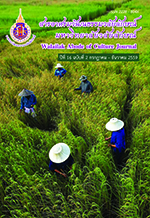โนรา: การเปลี่ยนแปลงการปรับตัวและพลังสร้างสรรค์ ในการดำรงอยู่ของคีตนาฏยลักษณ์แห่งภาคใต้
Main Article Content
Abstract
ภาคใต้มีศิลปะการละเล่นและการแสดงพื้นบ้านหลายอย่างที่ทำหน้าที่ในการให้ความบันเทิงและการประกอบพิธีกรรม ไม่ว่าจะเป็นเพลงบอก ลิเกป่า หนังตะลุง โดยเฉพาะโนรายอมรับกันว่าเป็นศิลปะการละเล่นและการแสดงพื้นบ้านที่มีความเก่าแก่และมีพัฒนาการมาควบคู่กับสังคมชาวใต้ ในด้านประวัติและพัฒนาการของโนราในภาคใต้นักวิชาการและผู้รู้ท้องถิ่นต่างเน้นย้ำว่าแหล่งกำเนิดโนราหรือพัฒนาการของโนรานั้นอยู่ในบริเวณลุ่มน้ำทะเลสาบสงขลา คือพื้นที่ทั้งหมดของจังหวัดพัทลุงในปัจจุบัน และบางส่วนของพื้นที่ในจังหวัดนครศรีธรรมราช และจังหวัดสงขลาที่เป็นรอยต่อของทะเลสาบสงขลาปรากฏตำนานของโนราหลายกระแสทั้งตำนานที่มาจากคำบอกเล่าของชาวบ้าน บทกาศครูบทเรียงกลอนของโนรา และจากหลักฐานจากเอกสารโดยเห็นว่าที่มาของโนรามีความเนื่องกับวัฒนธรรมฮินดูของอินเดีย โดยโนราเป็นการร่ายรำสำหรับบูชาเทพเจ้าในศาสนาพราหมณ์ เมื่อพราหมณ์เข้าสู่ภาคใต้จึงได้นำการละเล่นชนิดนี้เข้ามาด้วยโดยเชื่อกันว่า “ละครโนห์ราชาตรี” ได้ต้นแบบมาจาก “ละครรำกถากะลี” ของอินเดียใต้ โดย เข้ามาทางคาบสมุทร (ภาคใต้) ของประเทศไทยราวพุทธศตวรรษที่ 13 – 16 ซึ่งเป็นช่วงที่อาณาจักรศรีวิชัยเจริญรุ่งเรือง แล้วค่อยพัฒนาการจากศิลปะเพื่อการประกอบพิธีกรรมมาเป็นศิลปะเพื่อความบันเทิงและกลายเป็นนาฏกรรมของราชสำนักและของท้าวพระยามหากษัตริย์ในภาคใต้ และมีเอกลักษณ์เฉพาะที่ การรำโนราต้องประกอบด้วยบทรำ บทร้องและการแสดงเป็นเรื่อง จึงต้องฝึกฝนด้วยการฝึกรำแม่ท่า การฝึกรำทำบท และการฝึกรำเฉพาะอย่าง โนราจึงเป็นคีตนาฏยลักษณ์ของภาคใต้ที่มีทั้งกระบวนรำ และกระบวนการขับร้องอย่างไรก็ตามโนราย่อมมีการปรับตัวและการเปลี่ยนแปลงตามยุคสมัยด้วยเหตุและปัจจัยต่าง ๆไม่ว่าจะเป็นไปโดยธรรมชาติของวัฒนธรรมพื้นบ้านที่ต้องมีการเปลี่ยนแปลง ความก้าวหน้าทางเทคโนโลยีและวิทยาการสมัยใหม่ การรับอิทธิพลทางวัฒนธรรมจากภายนอก การศึกษามีความก้าวหน้า ความสะดวกรวดเร็วในการคมนาคมและการสื่อสาร การเข้ามาสนับสนุนละส่งเสริมของนักวิชาการและสถาบันการศึกษา การเปลี่ยนแปลงทางสังคมและวัฒนธรรมโนราจึงต้องปรับตัวทั้งรูปแบบและเนื้อหาเพื่อให้สามารถสนองตอบความต้องการและค่านิยมของสังคมในแต่ละช่วงเวลาจึงจะสามารถดำรงอยู่ได้มาจนถึงปัจจุบัน และยังกล่าวได้อีกว่าการดำรงอยู่ของโนรานั้นยังเกิดจากพลังสร้างสรรค์ของโนราด้วย ในฐานะที่โนราเป็นสื่อพื้นบ้าน เป็น “สถาบันศิลปะและนันทนาการ” มีส่วนในการทำหน้าที่เพื่อความมีเสถียรภาพของสังคมส่วนรวม โนราจึงมีบทบาทหน้าที่ทั้งด้านความบันเทิง การประกอบพิธีกรรม การสร้างเอกภาพและสัมพันธภาพในสังคม การถ่ายทอดวัฒนธรรมชุมชน รวมทั้งการสร้างอัตลักษณ์ ศักยภาพ และภูมิปัญญาท้องถิ่นและหน้าที่อื่น ๆ ซึ่งเราสามารถมองเห็นได้จากวิถีชีวิตของชาวบ้าน ทั้งด้านความบันเทิง ความเชื่อ เศรษฐกิจ การเมือง ชีวิตความเป็นอยู่ ทัศนคติ อารมณ์ การใช้เหตุผล และความรู้สึกนึกคิดต่าง ๆ ของคนในชุมชน
Norah: Change, Adaptation and Creative Power for Sustainability of the Southern Lyrical Dance Identity
The southern region of Thailand has various types of folk plays and local performances as a form of entertainment or ritual, such as ‘Pleng Bok,’ ‘Likay Pa,’ ‘Nang Talung,’ and especially ‘Norah,’ which is widely accepted as old vernacular tradition concurrently developed with southerners’ society. In terms of the history and evolution of Norah in the south, academics and local scholars affirm that the origin and development of Norah lies in the area of Songkhla lake basin, which is the whole area of Phatthalung province nowadays, some parts of Nakhon Si Thammarat province, and the area in contact between the lake and Songkhla province. Many historical records on Norah are by word of mouth, ‘Bot Kad Kru,’ ‘Bot Rieng Glon,’ and some documents which show the link between Norah and Hindu culture of India because Norah was a dance to warship gods in Brahmanism. When Brahmins arrived in the south, they brought along this performance. It is believed that ‘Lakhon Norahchatree’ had its root in ‘Lakhon Ramkatakalee’ of south India through the journey to the southern peninsular of Thailand around the 13th to 16th BCE during the rise of Srivijaya Kingdom. Norah, then, gradually evolved from ritual art to entertaining art and became dramatic works of royal courts and rulers in the south with its own identity. The Norah performance consists of a dance routine, melodious chant, and acting following the storyline. The performers are required to practice the prototypical routine, lyrical routine, and special routine. Norah is accordingly the lyrical dance identity of the south with both dance routines and lyric parts. However, the performance has to change and adapt through time depending on a number of factors, such as the natural transition of local culture, advancement of technology, external cultural impact, progress of education, convenience in communication, support from academics and educational institutions, and socio-cultural change. Norah, therefore, has adjusted both the form and content to serve the need and social value of different time periods so as to survive to the present. It can also be said that the existence of Norah is asserted because of its creativity as well. Since Norah is a vernacular means and “arts and recreation institute,” which takes part in the soundness of society in general, it plays a role in entertaining, undergoing the rituals, fostering unity and solidarity in society, transferring folk culture as well as developing identity, ability, local wisdom, and other duties which can be seen from folkways of entertainment, belief, economy, politics, way of life, attitude, emotion, reasoning and feelings of people in the community.
Article Details
© 2018 by Asian Journal of Arts and Culture, Walailak University. All rights reserved.


